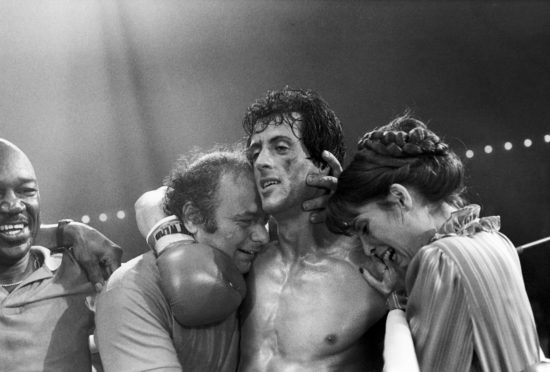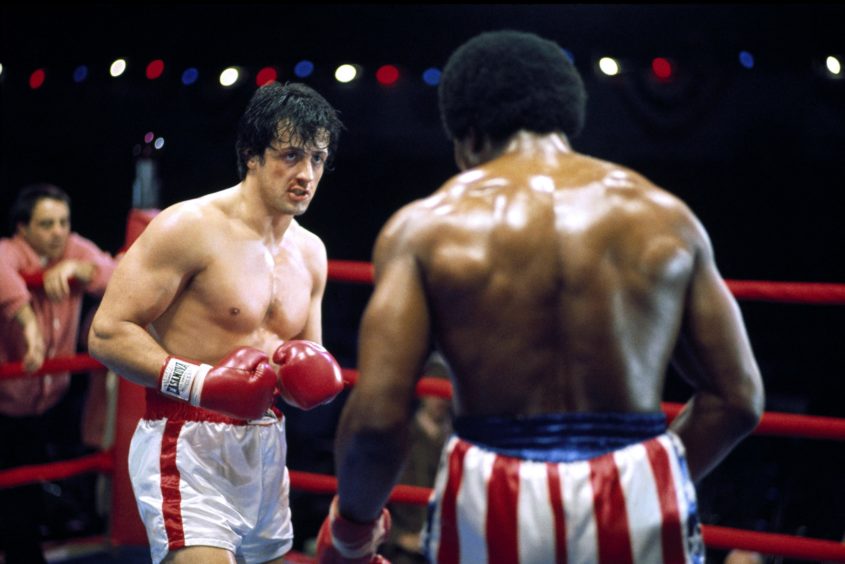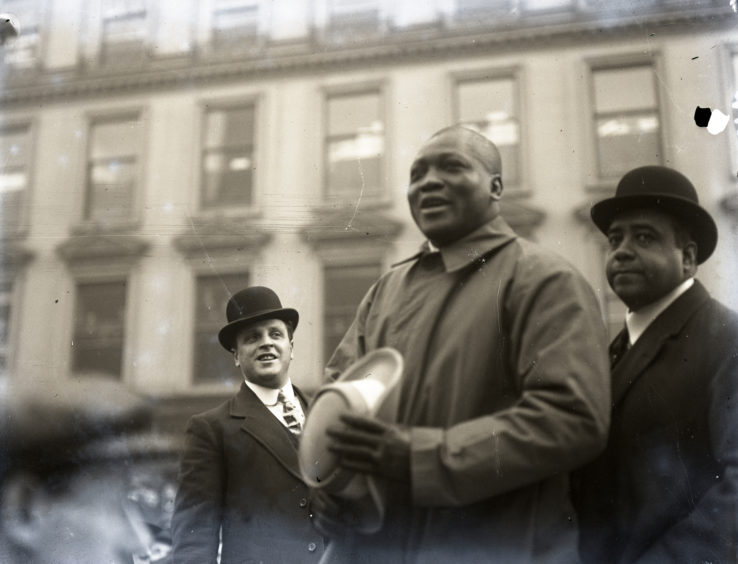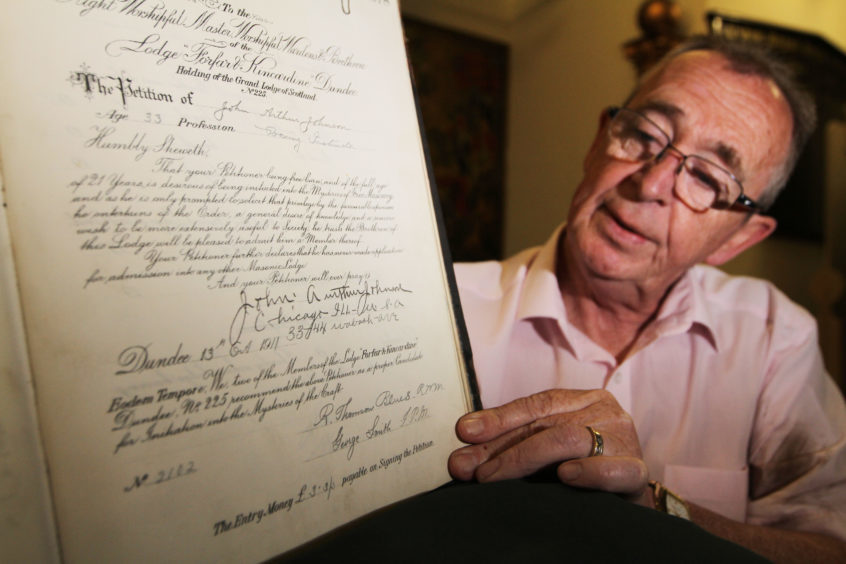Sylvester Stallone is to be given a history lesson on boxing hero Jack Johnson’s love affair with Dundee.
MGM is in development with Balboa Productions on a biopic about Johnson who was the first African American heavyweight champion of the world.
Jack Johnson, named by some historians as the single most important athlete in modern sports history, served as the inspiration for the character of Apollo Creed in the Rocky movies which were written by Stallone.
He was the first black man to win the world heavyweight title when he hammered Canadian Tommy Burns in the 14th round in Australia in 1908.
But he became a Freemason in Dundee three years later, donning his apron at Forfar and Kincardine, No. 225 Lodge, whilst visiting England where he was fighting at Earls Court.
Past Master Graham Letford has now written to Stallone to remind him of the Dundee initiation and how Johnson remains the most famous member of No. 225 Lodge.
During his spell in England he fought in exhibition matches and army officer Sydney McLaglen from Dundee told Johnson about his masonic lodge during a fight in Newcastle.
Early morning arrival in Dundee
He told Johnson he was due to travel to Dundee to receive the second degree and Johnson asked if he could go with him and join the lodge.
Johnson arrived at Tay Bridge Station at 5.30am from Newcastle and the lodge was called together for 10am.
During the closing part of the initiation ceremony a telegram was dispatched to Dundee from the Grand Lodge of Scotland demanding that the proceedings cease immediately.
However, the master decided that it was too late and continued with the ceremony regardless.
I will always have the greatest love for Dundee and Dundee masons.”
Johnson said: “This is the most glorious time of my life.
“My father-in-law was a mason and my wife desires me to be one.
“It has for long been my great desire to be a mason and I have now accomplished the first stage of the journey.
“I will always have the greatest love for Dundee and Dundee masons.”
After the ceremony a group of Johnson’s admirers carried him shoulder high through the hall to the taxi which was waiting outside.
The taxi drove off amid cheers and arrived at the Royal Hotel to pick up his wife.
A big crowd gathered and he was loudly cheered.
At the station he had to run the gauntlet of another big crowd to get to the platform and into his compartment.
Johnson left by train for Newcastle and said he was proud to belong to the craft.
He stated he would certainly go back to Dundee to have his second degree conferred some time in early December.
Johnson’s initiation cost the master at the time a two-year suspension from the craft.
Two other past masters received one-year suspensions and the lodge had its charter lifted for 18 months.
This was because its members refused to bow to pressure from the American Grand Lodge and the Grand Lodge of Scotland to send him back the three guineas he had paid to become a member.
Most Grand Lodges in the USA threatened to withdraw their Scottish Grand Lodge representation and this was why the Grand Lodge had attempted to halt Johnson’s initiation ceremony.
Mr Letford said: “Sylvester and his company Balboa Productions making a film of Johnson’s life would delight the Dundee masons who are so proud of their most famous member and also to the stance their Brethren took standing firm in the part they played in Johnson joining the Lodge.
“An invitation detailing the circumstances, the subsequent closure of the Lodge and its members suspension, and the documentation from the Grand Lodges in Scotland and America, has been sent to Stallone and his production team in the hope that this moment in time will be captured in the film, also to the love affair Johnson had with Dundee, hence his return a few years later.
“Here’s hoping we get a visit.”
A fugitive for seven years
In 1913 Johnson was convicted of violating the Mann Act for bringing his white girlfriend across state lines before their marriage.
Sentenced to prison, he fled to Europe, remaining there as a fugitive for seven years.
He continued to fight overseas, including two defences of the world title in Paris before he lost to Jess Willard in 1915.
Willard was a working cowboy from Kansas who knocked out Johnson in the 26th round of the scheduled 45 round fight in front of 25,000 at Oriental Park Racetrack in Havana, Cuba.
He returned to the city in a later visit during his spell in exile and was booked for exhibition shows called ‘Seconds Out’ at the King’s Theatre in Cowgate in 1916 where he took the city by storm over a seven day period.
Queues formed every morning to make certain of seats for the first house matinee and by late afternoon crowds were gathering in the Cowgate for the evening show.
According to one report Johnson did a bit of sparring and then “fought” a local character called Tommy Dodds who was just four feet tall.
Dodds went on to knock out the champ by hitting him on the knee.
Also on the bill were circus acts including elephants.
He returned to the USA in 1920 and served his sentence.
Johnson never again fought for the world title.
Galveston Giant
The son of former slaves, Jack Johnson was born in Galveston, Texas, in 1878.
He won the unofficial black heavyweight championship in 1903 with a 20-round decision over Denver Ed Martin.
Because of his race, however, Johnson was repeatedly denied the chance to fight James Jeffries for the heavyweight championship.
White boxers would not spar with their black counterparts but Johnson finally got his chance on Boxing Day in 1908 when then champion Tommy Burns fought him in Sydney, Australia.
Burns, who had succeeded Jeffries as world champion, only agreed to fight Johnson after promoters guaranteed him $30,000.
The Fight of the Century
Johnson defended his title four times when Jeffries came out of retirement to face Johnson in the “Fight of the Century” in Reno, Nevada, in July 1910.
When accepting the terms, the former champion said he was responding to “that portion of the white race that has been looking to me to defend its athletic superiority”.
Fearing racial violence in the event of a Johnson victory, the promoters did not allow the sale of alcohol.
Firearms were checked at the gate.
A crowd of more than 30,000 fans of both races watched the fight.
In round 14 Johnson put Jeffries on the canvas three times which was the first time in his career he had been knocked down.
The former champ’s corner threw in the towel.
The result led to deadly race riots across the country.
Still fighting aged 67
Hundreds of people of both races were injured and several were killed.
Jeffries said: “I could never have whipped Johnson at my best.
“I couldn’t have hit him.
“No, I couldn’t have reached him in 1,000 years.”
After his release, he fought sporadically until he retired at the age of 53, finishing with a career record of 71 wins, 11 losses and 11 draws.
He continued to fight after retiring in what was known as “cellar” fighting, where the bouts, unadvertised, were fought for private audiences.
There are photographs of one of these fights when Johnson made his final ring appearance aged 67 in 1945, fighting three one-minute exhibition rounds against two opponents, Joe Jeanette and John Ballcort, in a benefit fight card for US War Bonds.
Johnson’s complete record as a professional prize fighter has never been compiled.
Boxing was still a very underground and illegal activity in most of the country and official details were not recorded during his early career.
He died as a result of a traffic collision in in 1946 in Raleigh, North Carolina, at the age of 68.
Johnson had stopped to eat at a diner and the owner made him sit in the back, out of sight from white patrons.
Johnson drove away incensed and lost control around a sharp curve and crashed into a telephone pole.
Full posthumous pardon
In 1970, Johnson was portrayed by actor James Earl Jones in the film adaptation The Great White Hope, which was sourced from the 1967 play by Howard Sackler.
Twenty years later, Johnson was inducted into the International Boxing Hall of Fame and his life also became the subject of the acclaimed Ken Burns’ documentary Unforgivable Blackness.
In April 2018, President Donald Trump tweeted that, after receiving a phone call from Sylvester Stallone, he was considering a full posthumous pardon for Johnson’s violation of the Mann Act.
In May 2018, Trump granted Johnson a posthumous pardon.














